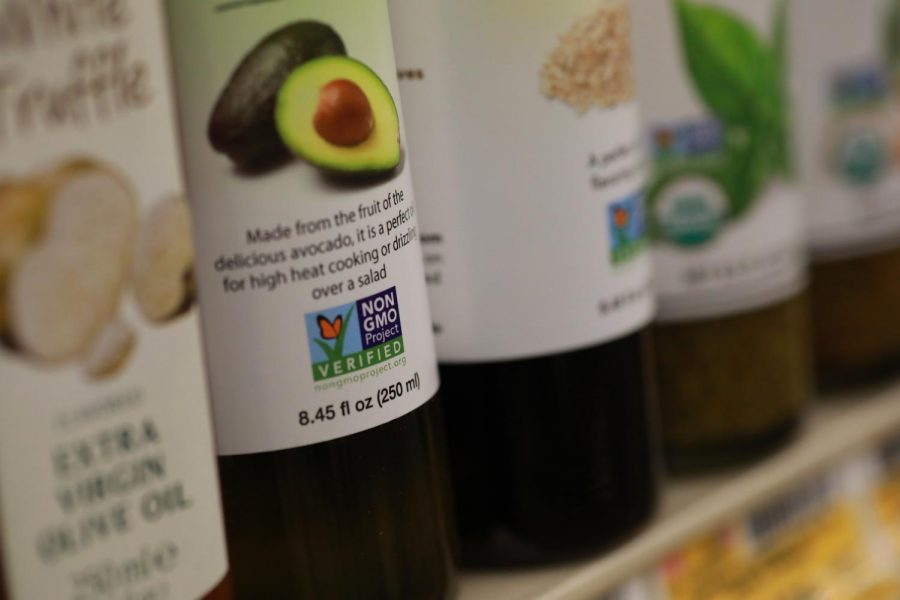GMO Food Can Feed the World, But Is It Safe?
June 5, 2019
All across the globe, a new method of farming has taken over. GMO foods have found their way to grocery store shelves everywhere, but not without its fair share of controversy. According to GMO Answers, plant breeders have been using genetic engineering, also known as biotechnology, “to take a desirable trait found in nature and transfer it from one plant or organism to the plant they want to improve, as well as make a change to an existing trait in a plant they are developing.”
One may think that the consumption of GMO foods are uncommon, but according to Center For Food Safety, 92 percent of U.S. corn is genetically modified, along with 94 percent of soybeans and cotton. CFS has predicted that about 75 percent of all processed foods on supermarket shelves contain some sort of genetically engineered ingredient. Chances are, the average American consumes some sort of GMO every day.
Sophomore Audrey Davis said that she eats GMO foods, but admitted that it is mostly because she often does not have option when she goes to the grocery store. “The main reason I eat them is because they are hard to get around when so many crops are genetically modified nowadays.” Senior Grayson Modica also eats GMO food, but was more confident in his decision to do so. “I do not think about it too much,” said Modica.
GMO foods were introduced for a reason, and they have reportedly had many positive impacts on the taste and appearance of food and the mass in which it is distributed. Food has been engineered to have stronger colors, increased shelf life, and also enabled plants like watermelons to be produced without their seeds in them. Even the nutrients in foods can be amplified. According to Healthline, levels of nutrients such as protein, calcium and folate can be amplified by genetic modification.
Food can be overall better thanks to GMOs, but can also be produced at a much greater rate. For example, one benefit of genetically modified crops is their ability to resist pests and weeds. As reported by Forbes, “Crops resistant to either pest or weeds yield on average 10% more grain, and crops resistant to both deliver a 25% increase in grain yield.”
GMOs can also help find sustainable ways to feed people in developing countries across the world; ones that specifically lack access to nutrient-rich food. According to Healthline, “The heartiness of some GM crops makes it so they can grow in marginal environments. The longer shelf life of some GM foods allows them to be shipped to remote areas.”
Not only does this bioengineering help feed humans, but it also helps animals grow. According to PubMed, “Billions of edible animals are raised in this country each year on feed containing GMOs, with no evidence of harm. In fact, animal health and growth efficiency actually improved on the genetically engineered feed.”
There appears to be remarkable potential from genetically modified organisms. From how food looks, to how it tastes, to how much of it can be produced, the upside has clearly convinced many to support GMO foods. However, much about the bioengineering and what is actually modified in these crops is rather unknown. This has arguably been the main factor driving the controversy surrounding GMOs.
Recently, food allergies have emerged as a growing problem in the United States. According to the Centers for Disease Control and Prevention, “Food allergies in children under 18 years of age have increased; from 3.4 percent between 1997 and 1999 to 5.1 percent between 2009 and 2011.” Some people believe that spike is linked to GM foods. But a study conducted by Harvard University proved that “there’s no evidence that GMO foods in general are more likely to trigger allergic reactions than non-GM foods.”
Additionally, there is concern that antibiotic-resistant bacteria, which is a commonly used gene in the genetic engineering process, is passing on germs and infecting people. Antibiotic resistant germs kill over 23,000 people per year, according to the CDC, but there is no evidence to prove that there is a link between GMO foods and antibiotic resistant bacteria at this current moment.
Because of some of these concerns, The American Academy of Environmental Medicine, whose mission statement on their website is to “promote optimal health through prevention, and safe and effective treatment of the causes of illness by supporting physicians and other professionals in serving the public through education about the interaction between humans and their environment,” urges doctors to prescribe non-GMO diets for all patients.
The Academy cites animal studies showing “organ damage, gastrointestinal and immune system disorders, accelerated aging, and infertility,” in animals that ate GMO crops. It also cites human studies in which “genetically modified (GM) food can leave material behind inside us, possibly causing long-term problems. For example, toxic insecticide produced by GM corn was found in the blood of pregnant women and their unborn fetuses.”
All these concerns could be quite serious, but problematically, there is a lack of evidence to connect the possible effects of GMO foods and their impacts on everyday people. This further goes to demonstrate that there is a clear disparity in knowledge of the genetic modification of crops and food. Because of this lack of information, it is understandable for people to be so concerned about the potential consequences of bioengineering.
Furthermore, the Institute for Responsible Technology reported that between 1996 and 2008, “US farmers sprayed an extra 383 million pounds of herbicide on GMOs.” Products like Roundup have resulted in GMO food to contain higher residues of toxic herbicides. Roundup has been linked with “sterility, hormone disruption, birth defects, and cancer.” But, again there is no evidence to really prove that GMO foods cause those diseases and deficiencies.
In conclusion, the controversy surrounding genetically modified organisms will most likely continue for a while. There needs to be more research surrounding the topic to fully understand the consequences. However, Issaquah students seem more optimistic about the future of them. “In five years, I see them being more in our food because the food tastes better, so more people are going to want to eat them naturally,” said freshman Emma Mazzotta. Junior Alexander Lau agreed: “I see there being many more of them and if the people decide that they are more open to eating them, the industry will continue to grow and there will be more GMO foods.” But for now, the truth surrounding GMO foods will continue to be a mystery.




lee • Jul 15, 2019 at 11:40 pm
My favorite saying we are what we eat holds true in every article I read. Eating healthy food especially the organic ones will give us holistic health benefit.. increasing nutritious, fiber-rich food and water intake will also help a lot in getting rid of diseases and will boost our immune system as well.